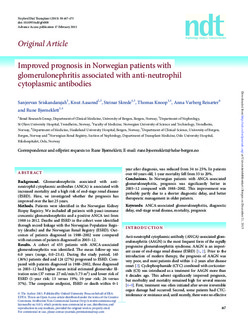| dc.contributor.author | Sriskandarajah, Sanjeevan | |
| dc.contributor.author | Aasarød, Knut | |
| dc.contributor.author | Skrede, Steinar | |
| dc.contributor.author | Knoop, Thomas | |
| dc.contributor.author | Reisæter, Anna Varberg | |
| dc.contributor.author | Bjørneklett, Rune | |
| dc.date.accessioned | 2015-12-21T20:12:39Z | |
| dc.date.accessioned | 2016-03-04T12:50:33Z | |
| dc.date.available | 2015-12-21T20:12:39Z | |
| dc.date.available | 2016-03-04T12:50:33Z | |
| dc.date.issued | 2014 | |
| dc.identifier.citation | Nephrology, Dialysis and Transplantation 2014, 30:i67-i75 | nb_NO |
| dc.identifier.issn | 1460-2385 | |
| dc.identifier.uri | http://hdl.handle.net/11250/2381443 | |
| dc.description.abstract | Background: Glomerulonephritis associated with anti-neutrophil cytoplasmic antibodies (ANCA) is associated with increased mortality and a high risk of end-stage renal disease (ESRD). Here, we investigated whether the prognosis has improved over the last 25 years.
Methods: Patients were identified in the Norwegian Kidney Biopsy Registry. We included all patients with pauci-immune crescentic glomerulonephritis and a positive ANCA test from 1988 to 2012. Deaths and ESRD in the cohort were identified through record linkage with the Norwegian Population Registry (deaths) and the Norwegian Renal Registry (ESRD). Outcomes of patients diagnosed in 1988–2002 were compared with outcomes of patients diagnosed in 2003–12.
Results: A cohort of 455 patients with ANCA-associated glomerulonephritis was identified. The mean follow-up was 6.0 years (range, 0.0–23.4). During the study period, 165 (36%) patients died and 124 (27%) progressed to ESRD. Compared with patients diagnosed in 1988–2002, those diagnosed in 2003–12 had higher mean initial estimated glomerular filtration rates (37 versus 27 mL/min/1.73 m2) and lower risk of ESRD (1-year risk: 13 versus 19%; 10-year risk: 26 versus 37%). The composite endpoint, ESRD or death within 0–1 year after diagnosis, was reduced from 34 to 25%. In patients over 60 years old, 1-year mortality fell from 33 to 20%.
Conclusions: In Norwegian patients with ANCA-associated glomerulonephritis, prognosis was significantly better in 2003–12 compared with 1988–2002. This improvement was probably partly due to a shorter diagnostic delay, and better therapeutic management in older patients. | nb_NO |
| dc.language.iso | eng | nb_NO |
| dc.publisher | Oxford University Press | nb_NO |
| dc.title | Improved prognosis in Norwegian patients with glomerulonephritis associated with anti-neutrophil cytoplasmic antibodies | nb_NO |
| dc.type | Peer reviewed | nb_NO |
| dc.type | Journal article | |
| dc.date.updated | 2015-12-21T20:12:39Z | |
| dc.description.version | publishedVersion | |
| dc.source.volume | 30 | nb_NO |
| dc.source.journal | Nephrology, Dialysis and Transplantation | nb_NO |
| dc.identifier.doi | 10.1093/ndt/gfv008 | |
| dc.identifier.cristin | 1257730 | |
| dc.description.localcode | © The Author 2015. Published by Oxford University Press on behalf of ERAEDTA. This is an Open Access article distributed under the terms of the Creative Commons Attribution Non-Commercial License (http://creativecommons.org/licenses/by-nc/4.0/), which permits non-commercial re-use, distribution, and reproduction in any medium, provided the original work is properly cited. | nb_NO |
